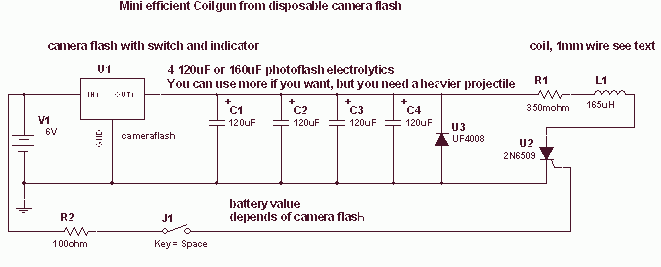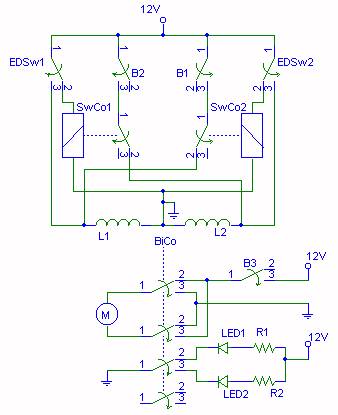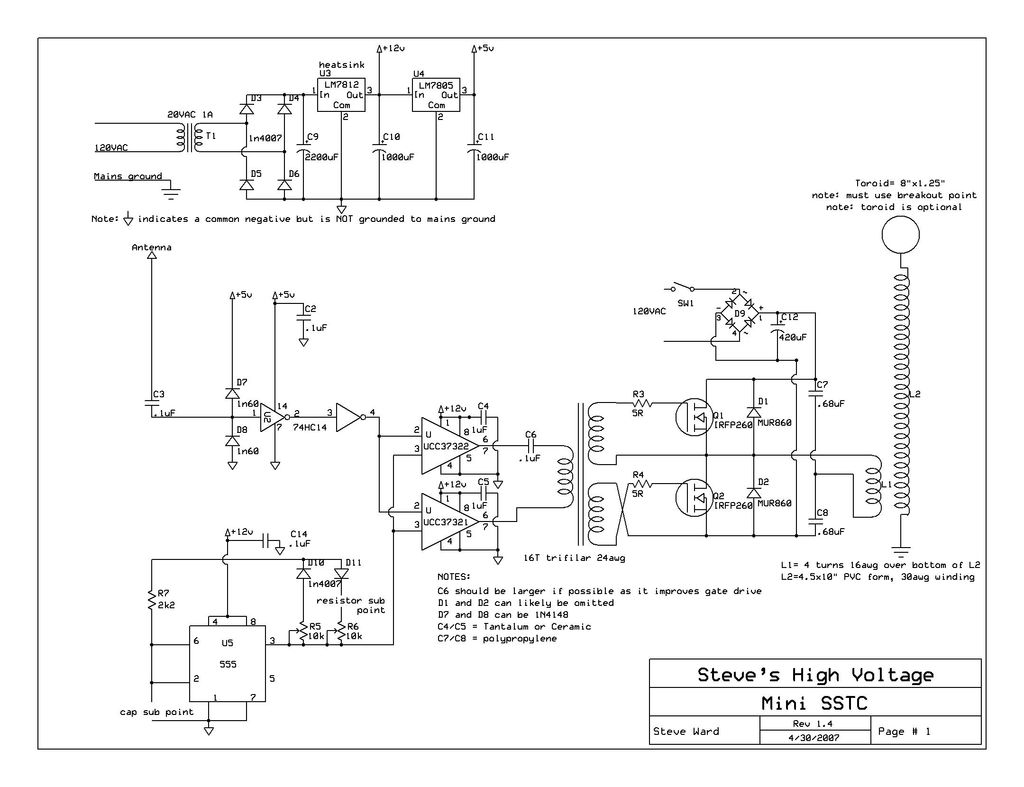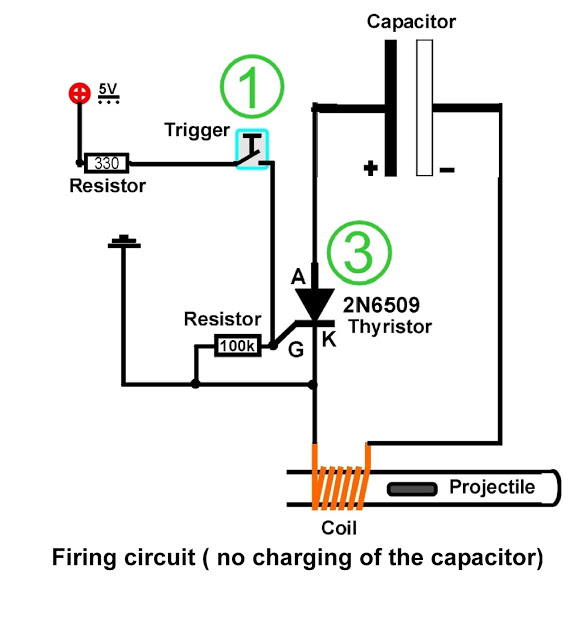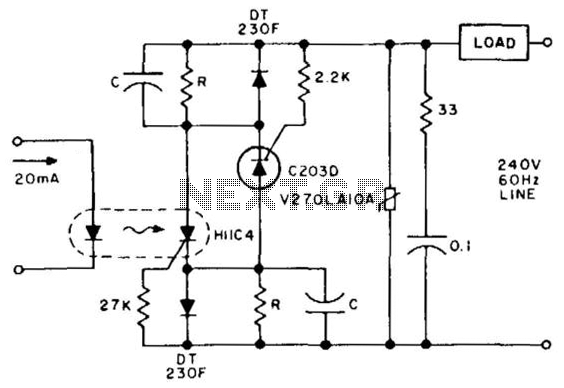
Solid-State Tesla Coil
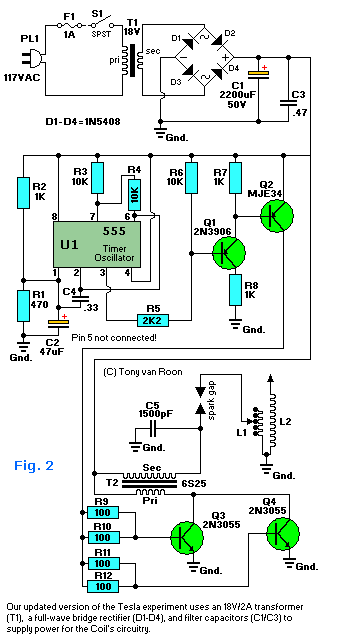
Most Tesla coils designed for educational and experimental purposes utilize line-operated, step-up transformer setups to generate the high voltage required for the coil's primary circuit. While this approach is technically sound, it poses a risk to the operator if the primary circuit is accidentally touched. Caution is advised, as a shock from the high-voltage winding can be extremely dangerous and potentially fatal. The "Solid State Tesla Coil" version eliminates the line-operated, high-voltage transformer, making it a safer project for construction and experimentation. Nevertheless, operators should exercise caution and avoid contact with the wiring while the coil is powered. The schematic diagram for the Solid-State Tesla Coil includes an 18-volt, 2-ampere transformer (T1), a bridge rectifier circuit (D1-D4), and filter capacitors (C1 and C3) that provide operating power for the coil circuitry. A 555 timer/oscillator (U1) is configured as a self-oscillating pulse generator. Resistors R1 and R2 form a voltage-divider network that reduces the 24-volt DC output of the power supply to a safe operating level for U1. The narrow output pulse from the 555 timer at pin 3 supplies drive current to the base of Q1. Transistor Q2 provides sufficient current to transistors Q3 and Q4, driving them into full saturation. The primary winding of T2 (an automobile ignition coil) is connected in series with Q3 and Q4 and across the power supply. Transistors Q3 and Q4 function as a toggle switch, connecting the coil to the power source at a rate and duration determined by U1. This high-current pulse generates a rising and collapsing magnetic field across the primary winding of T2, inducing a current in the secondary winding of T2. The secondary output of T2 is routed through three parallel-connected 500pF, 10-kilovolt doorknob capacitors (collectively designated as C5), which serve as an energy storage device. These capacitors charge to T1's secondary voltage and are subsequently discharged through the spark gap and the primary (L1) of the Tesla coil, resulting in a higher voltage in the secondary coil (L2). Due to the scarcity of variable 10-kilovolt capacitors, an alternative method is employed to tune L1. The simplest approach involves tapping the primary coil at every turn and selecting the tap that yields the highest voltage at the hot end of L2. The prototype was constructed in a breadboard style on an 11x11x1-inch wooden cutting board; however, any similar non-conducting material, such as plastic, can be used. Most of the small components were mounted on a 3x5-inch section of perfboard, with point-to-point wiring techniques utilized to complete the connections. Refer to the schematic diagram and accompanying photos for wiring and general parts layout details. Components T1 and T2, C5, Q3, Q4, F1, and S1 are not mounted to the perfboard. The positioning of the perfboard and off-board components on the baseboard is illustrated in the accompanying figures.
The Solid State Tesla Coil represents a significant advancement in Tesla coil design, prioritizing operator safety while maintaining the functionality required for educational demonstrations and experiments. The elimination of high-voltage transformers reduces the risk of electrical shock, making this design more accessible to hobbyists and educators. The use of a 555 timer as a pulse generator offers precise control over the operation of the coil, allowing for adjustable frequency and duty cycle. The bridge rectifier and filter capacitors ensure that the power supply delivers a stable DC voltage, which is critical for reliable operation.
The circuit's design emphasizes a modular approach, allowing for easy assembly and troubleshooting. The choice of components, including the use of an automobile ignition coil, is both practical and cost-effective, making it feasible for individuals to replicate the design. The tuning method employed for the primary coil enhances the coil's performance, enabling operators to optimize the output voltage.
Overall, the Solid State Tesla Coil schematic provides a comprehensive framework for constructing a high-voltage coil that is both effective and safer than traditional designs. The detailed components list and schematic diagram serve as essential references for builders, ensuring that each element is correctly implemented for optimal performance.Most Tesla coils designed for educational and experimental purposes use line-operated, step-up transformer-in setups like that shown in Fig. 1 -to generate the high voltage needed for the coil`s primary circuit. While there`s nothing technically wrong with that approach, it can place the operator in harm`s way if the coil`s primary circuit is accidentally touched.
CAREFUL! A shock from the high-voltage winding could prove extremely dangerous and may be fatal! Our version, the "Solid State Tesla Coil" (see photos), eliminates the line-operated, high-voltage transformer, making it a safer project to build and to experiment with. Even so, wise operators will keep their digits out of the wiring while the coil is under power. The schematic diagram for the Solid-State Tesla Coil is shown in Fig. 2. In that updated version of the Tesla experiment, an 18-volt, 2-ampere transformer (T1), a bridge rectifier circuit (consisting of D1-D4), and filter capacitors (C1and C3) supply operating power for the coil circuitry.
A 555 timer/oscillator (U1) is configure as a self-oscillating pulse-generator circuit. Resistors R1 and R2 make up a voltage-divider network, which is used to lower the 24-volt DC output of the power supply to a safe operating level for U1. The 555`s narrow output pulse at pin 3 supplies drive current to the base of Q1. Transistor Q2 supplies sufficient current to transistors Q3 and Q4 to drive those components into full saturation.
The primary winding of T2 (an automobile ignition coil) is connected in series with Q3 and Q4, and across the power supply. Transistors Q3 and Q4 operate like a toggle switch, connecting the coil across the power source at the rate and on-time set by U1.
That high-current pulse generates a rising and collapsing field across the primary winding of T2. The filed causes a current to be induced in the secondary winding of T2. The secondary output of T2 is fed across three 500pF, 10 kilovolt doorknob capacitors (collectively designated C5) that are parallel connected and tied across the high-voltage output of T2 as an energy-storage device. Those capacitors charge up to T1`s secondary voltage and are then discharged through the spark gap and the primary (L1) of the Tesla coil, producing higher voltage in the secondary of the coil (L2).
of the secondary coil. Because variable 10-kilovolt capacitors are about as common a Condor eggs, some other means must be used to tune L1. The simplest method is to tap the primary coil on every turn and select the tap that produces the greatest voltage at the hot end of L2.
The author`s prototype was built breadboard style on an 11x11x1-inch wooden cutting board (see photos), but any similar non-conducting material (perhaps plastic) will do. The majority of the small components, as shown in the photos, were mounted on a 3x5-inch section of perfboard, and point-to-point wiring techniques were used to complete the connections.
Refer to the schematic diagram (in Fig. 2) and the photos for wiring and general parts-layout details. Note: Components T1 and T2, C5, Q3 and Q4, F1, and S1 are not mounted to the perfboard (see photos). Figure 3 shows the positioning of the perfboard and off-board components on the baseboard. Mount the fully-populated perfboard assembly to the b 🔗 External reference
The Solid State Tesla Coil represents a significant advancement in Tesla coil design, prioritizing operator safety while maintaining the functionality required for educational demonstrations and experiments. The elimination of high-voltage transformers reduces the risk of electrical shock, making this design more accessible to hobbyists and educators. The use of a 555 timer as a pulse generator offers precise control over the operation of the coil, allowing for adjustable frequency and duty cycle. The bridge rectifier and filter capacitors ensure that the power supply delivers a stable DC voltage, which is critical for reliable operation.
The circuit's design emphasizes a modular approach, allowing for easy assembly and troubleshooting. The choice of components, including the use of an automobile ignition coil, is both practical and cost-effective, making it feasible for individuals to replicate the design. The tuning method employed for the primary coil enhances the coil's performance, enabling operators to optimize the output voltage.
Overall, the Solid State Tesla Coil schematic provides a comprehensive framework for constructing a high-voltage coil that is both effective and safer than traditional designs. The detailed components list and schematic diagram serve as essential references for builders, ensuring that each element is correctly implemented for optimal performance.Most Tesla coils designed for educational and experimental purposes use line-operated, step-up transformer-in setups like that shown in Fig. 1 -to generate the high voltage needed for the coil`s primary circuit. While there`s nothing technically wrong with that approach, it can place the operator in harm`s way if the coil`s primary circuit is accidentally touched.
CAREFUL! A shock from the high-voltage winding could prove extremely dangerous and may be fatal! Our version, the "Solid State Tesla Coil" (see photos), eliminates the line-operated, high-voltage transformer, making it a safer project to build and to experiment with. Even so, wise operators will keep their digits out of the wiring while the coil is under power. The schematic diagram for the Solid-State Tesla Coil is shown in Fig. 2. In that updated version of the Tesla experiment, an 18-volt, 2-ampere transformer (T1), a bridge rectifier circuit (consisting of D1-D4), and filter capacitors (C1and C3) supply operating power for the coil circuitry.
A 555 timer/oscillator (U1) is configure as a self-oscillating pulse-generator circuit. Resistors R1 and R2 make up a voltage-divider network, which is used to lower the 24-volt DC output of the power supply to a safe operating level for U1. The 555`s narrow output pulse at pin 3 supplies drive current to the base of Q1. Transistor Q2 supplies sufficient current to transistors Q3 and Q4 to drive those components into full saturation.
The primary winding of T2 (an automobile ignition coil) is connected in series with Q3 and Q4, and across the power supply. Transistors Q3 and Q4 operate like a toggle switch, connecting the coil across the power source at the rate and on-time set by U1.
That high-current pulse generates a rising and collapsing field across the primary winding of T2. The filed causes a current to be induced in the secondary winding of T2. The secondary output of T2 is fed across three 500pF, 10 kilovolt doorknob capacitors (collectively designated C5) that are parallel connected and tied across the high-voltage output of T2 as an energy-storage device. Those capacitors charge up to T1`s secondary voltage and are then discharged through the spark gap and the primary (L1) of the Tesla coil, producing higher voltage in the secondary of the coil (L2).
of the secondary coil. Because variable 10-kilovolt capacitors are about as common a Condor eggs, some other means must be used to tune L1. The simplest method is to tap the primary coil on every turn and select the tap that produces the greatest voltage at the hot end of L2.
The author`s prototype was built breadboard style on an 11x11x1-inch wooden cutting board (see photos), but any similar non-conducting material (perhaps plastic) will do. The majority of the small components, as shown in the photos, were mounted on a 3x5-inch section of perfboard, and point-to-point wiring techniques were used to complete the connections.
Refer to the schematic diagram (in Fig. 2) and the photos for wiring and general parts-layout details. Note: Components T1 and T2, C5, Q3 and Q4, F1, and S1 are not mounted to the perfboard (see photos). Figure 3 shows the positioning of the perfboard and off-board components on the baseboard. Mount the fully-populated perfboard assembly to the b 🔗 External reference
